Exploring the Wonders of Autumn
VerifiedAdded on 2020/04/21
|9
|1301
|343
AI Summary
This kindergarten lesson plan focuses on exploring the theme of autumn. Activities include leaf painting, creating masks, reciting a poem about falling leaves, planting apple and pumpkin seeds, and discussing the changes nature undergoes during this season. The plan incorporates differentiated instruction to cater to diverse learning styles and accommodations for students with disabilities. Extensions and enrichment activities are also suggested to further engage students.
Contribute Materials
Your contribution can guide someone’s learning journey. Share your
documents today.
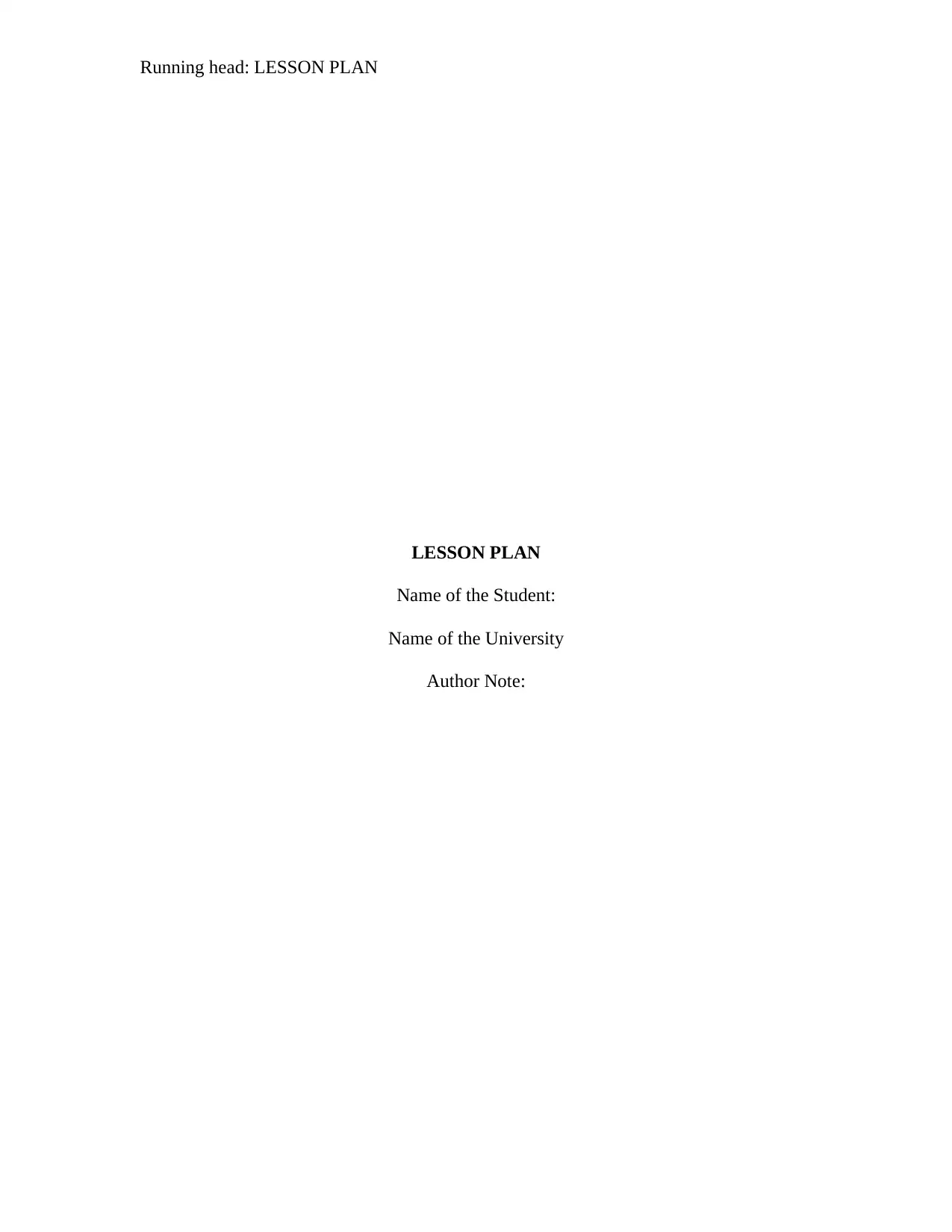
Running head: LESSON PLAN
LESSON PLAN
Name of the Student:
Name of the University
Author Note:
LESSON PLAN
Name of the Student:
Name of the University
Author Note:
Secure Best Marks with AI Grader
Need help grading? Try our AI Grader for instant feedback on your assignments.
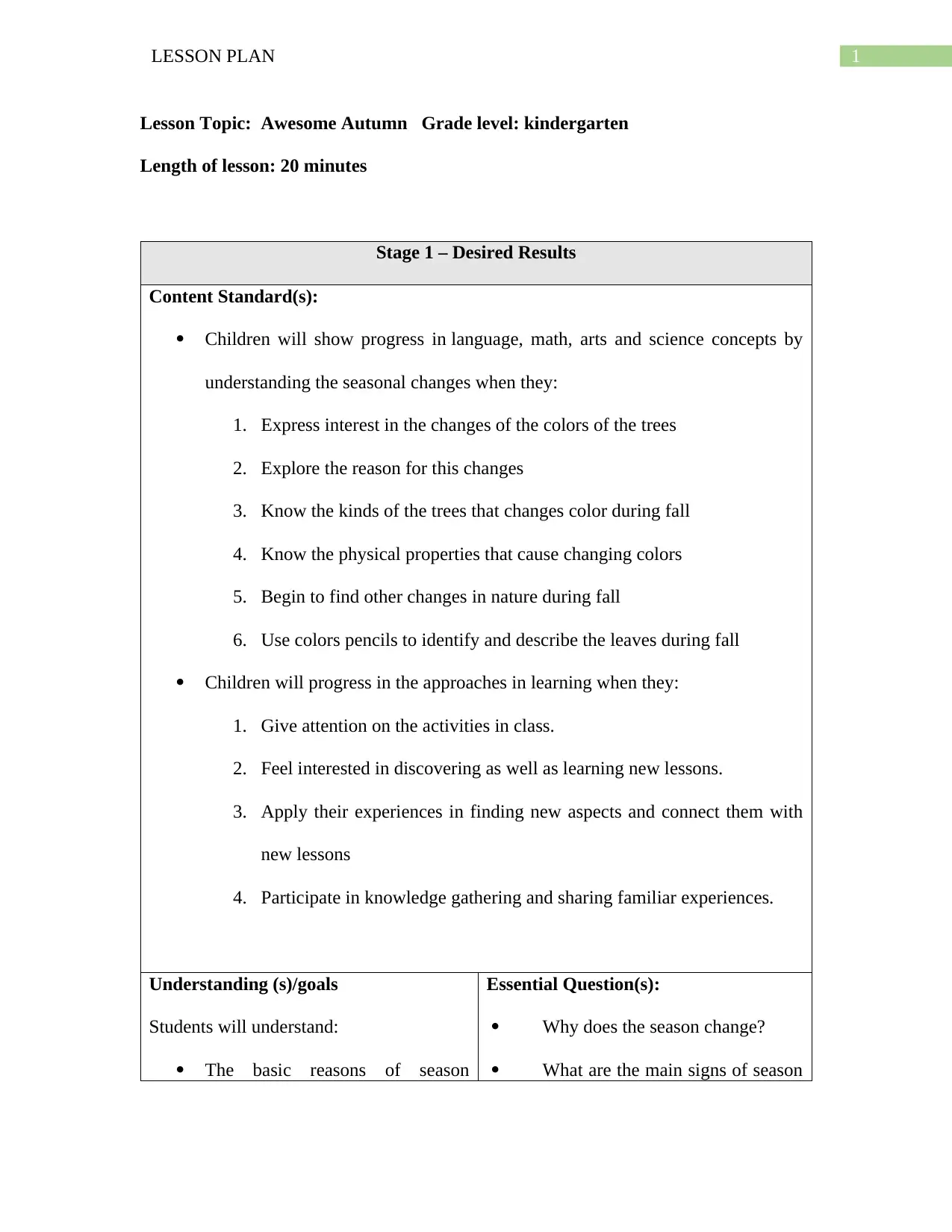
1LESSON PLAN
Lesson Topic: Awesome Autumn Grade level: kindergarten
Length of lesson: 20 minutes
Stage 1 – Desired Results
Content Standard(s):
Children will show progress in language, math, arts and science concepts by
understanding the seasonal changes when they:
1. Express interest in the changes of the colors of the trees
2. Explore the reason for this changes
3. Know the kinds of the trees that changes color during fall
4. Know the physical properties that cause changing colors
5. Begin to find other changes in nature during fall
6. Use colors pencils to identify and describe the leaves during fall
Children will progress in the approaches in learning when they:
1. Give attention on the activities in class.
2. Feel interested in discovering as well as learning new lessons.
3. Apply their experiences in finding new aspects and connect them with
new lessons
4. Participate in knowledge gathering and sharing familiar experiences.
Understanding (s)/goals
Students will understand:
The basic reasons of season
Essential Question(s):
Why does the season change?
What are the main signs of season
Lesson Topic: Awesome Autumn Grade level: kindergarten
Length of lesson: 20 minutes
Stage 1 – Desired Results
Content Standard(s):
Children will show progress in language, math, arts and science concepts by
understanding the seasonal changes when they:
1. Express interest in the changes of the colors of the trees
2. Explore the reason for this changes
3. Know the kinds of the trees that changes color during fall
4. Know the physical properties that cause changing colors
5. Begin to find other changes in nature during fall
6. Use colors pencils to identify and describe the leaves during fall
Children will progress in the approaches in learning when they:
1. Give attention on the activities in class.
2. Feel interested in discovering as well as learning new lessons.
3. Apply their experiences in finding new aspects and connect them with
new lessons
4. Participate in knowledge gathering and sharing familiar experiences.
Understanding (s)/goals
Students will understand:
The basic reasons of season
Essential Question(s):
Why does the season change?
What are the main signs of season
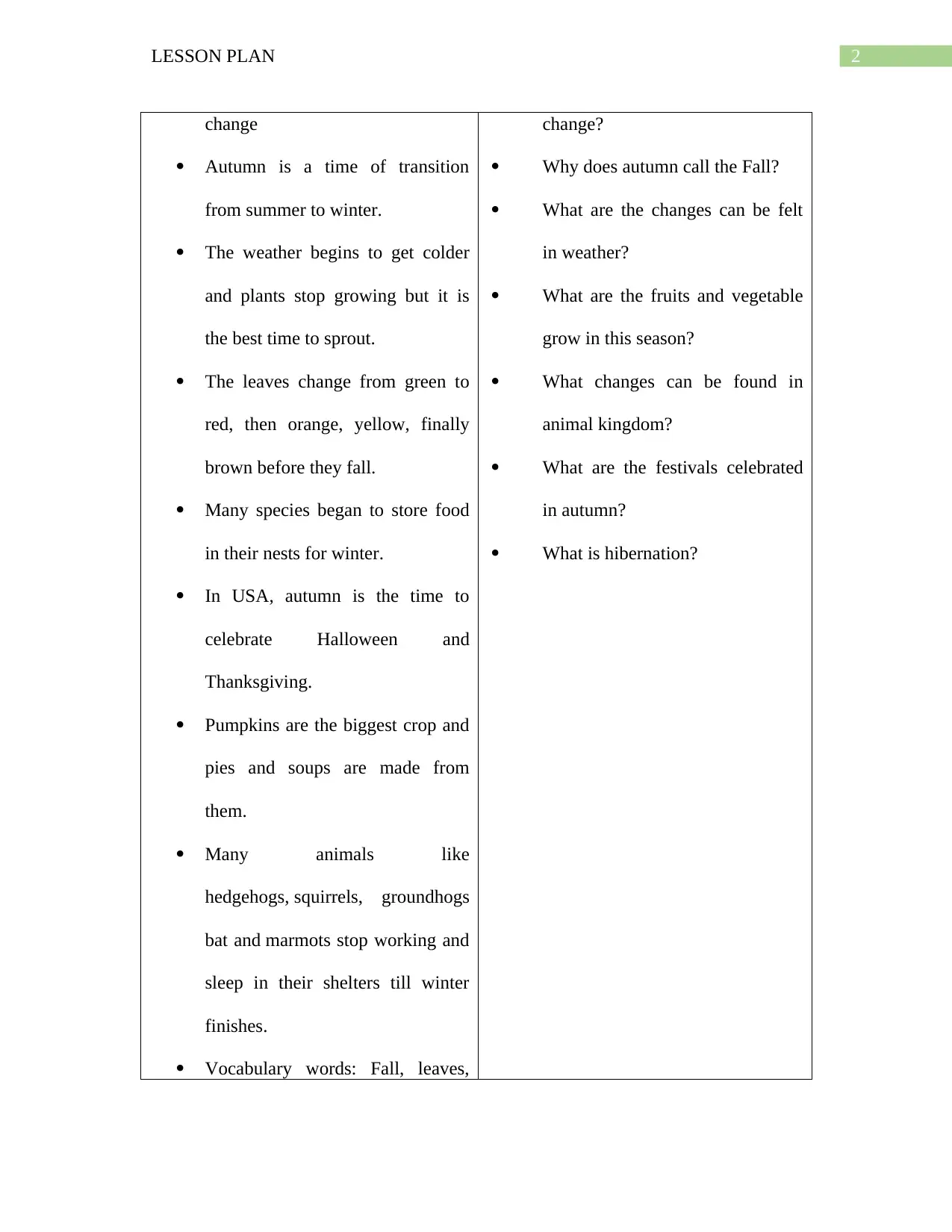
2LESSON PLAN
change
Autumn is a time of transition
from summer to winter.
The weather begins to get colder
and plants stop growing but it is
the best time to sprout.
The leaves change from green to
red, then orange, yellow, finally
brown before they fall.
Many species began to store food
in their nests for winter.
In USA, autumn is the time to
celebrate Halloween and
Thanksgiving.
Pumpkins are the biggest crop and
pies and soups are made from
them.
Many animals like
hedgehogs, squirrels, groundhogs
bat and marmots stop working and
sleep in their shelters till winter
finishes.
Vocabulary words: Fall, leaves,
change?
Why does autumn call the Fall?
What are the changes can be felt
in weather?
What are the fruits and vegetable
grow in this season?
What changes can be found in
animal kingdom?
What are the festivals celebrated
in autumn?
What is hibernation?
change
Autumn is a time of transition
from summer to winter.
The weather begins to get colder
and plants stop growing but it is
the best time to sprout.
The leaves change from green to
red, then orange, yellow, finally
brown before they fall.
Many species began to store food
in their nests for winter.
In USA, autumn is the time to
celebrate Halloween and
Thanksgiving.
Pumpkins are the biggest crop and
pies and soups are made from
them.
Many animals like
hedgehogs, squirrels, groundhogs
bat and marmots stop working and
sleep in their shelters till winter
finishes.
Vocabulary words: Fall, leaves,
change?
Why does autumn call the Fall?
What are the changes can be felt
in weather?
What are the fruits and vegetable
grow in this season?
What changes can be found in
animal kingdom?
What are the festivals celebrated
in autumn?
What is hibernation?
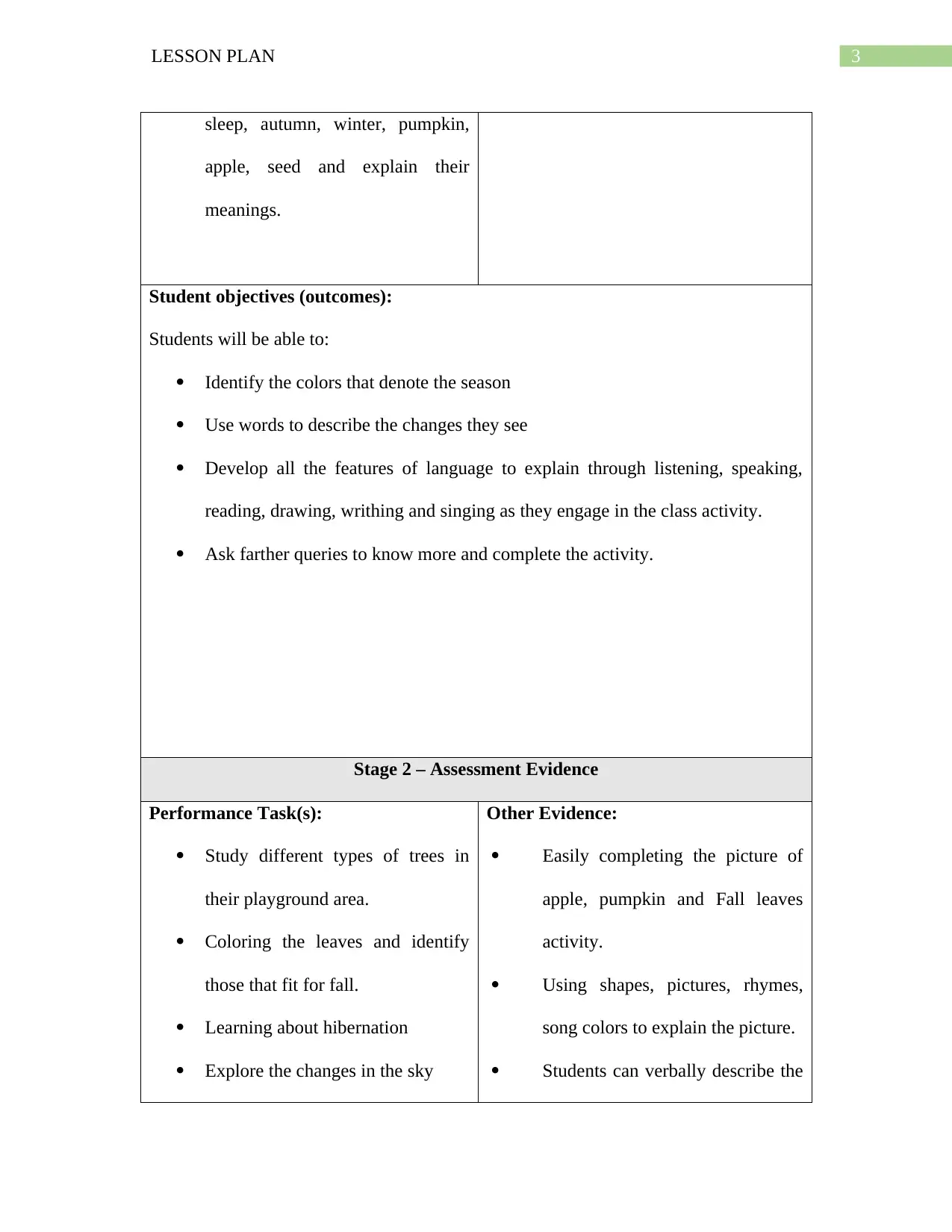
3LESSON PLAN
sleep, autumn, winter, pumpkin,
apple, seed and explain their
meanings.
Student objectives (outcomes):
Students will be able to:
Identify the colors that denote the season
Use words to describe the changes they see
Develop all the features of language to explain through listening, speaking,
reading, drawing, writhing and singing as they engage in the class activity.
Ask farther queries to know more and complete the activity.
Stage 2 – Assessment Evidence
Performance Task(s):
Study different types of trees in
their playground area.
Coloring the leaves and identify
those that fit for fall.
Learning about hibernation
Explore the changes in the sky
Other Evidence:
Easily completing the picture of
apple, pumpkin and Fall leaves
activity.
Using shapes, pictures, rhymes,
song colors to explain the picture.
Students can verbally describe the
sleep, autumn, winter, pumpkin,
apple, seed and explain their
meanings.
Student objectives (outcomes):
Students will be able to:
Identify the colors that denote the season
Use words to describe the changes they see
Develop all the features of language to explain through listening, speaking,
reading, drawing, writhing and singing as they engage in the class activity.
Ask farther queries to know more and complete the activity.
Stage 2 – Assessment Evidence
Performance Task(s):
Study different types of trees in
their playground area.
Coloring the leaves and identify
those that fit for fall.
Learning about hibernation
Explore the changes in the sky
Other Evidence:
Easily completing the picture of
apple, pumpkin and Fall leaves
activity.
Using shapes, pictures, rhymes,
song colors to explain the picture.
Students can verbally describe the
Secure Best Marks with AI Grader
Need help grading? Try our AI Grader for instant feedback on your assignments.
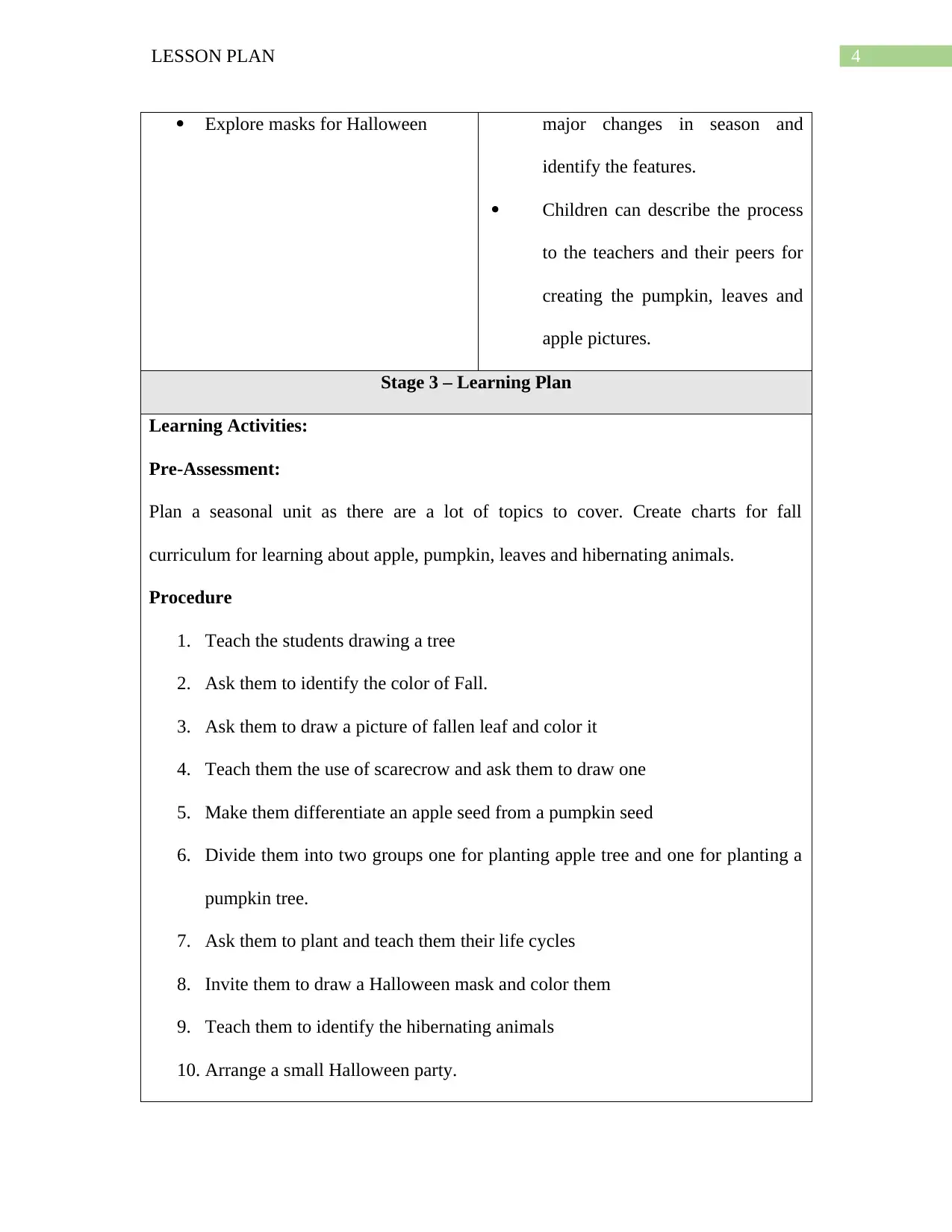
4LESSON PLAN
Explore masks for Halloween major changes in season and
identify the features.
Children can describe the process
to the teachers and their peers for
creating the pumpkin, leaves and
apple pictures.
Stage 3 – Learning Plan
Learning Activities:
Pre-Assessment:
Plan a seasonal unit as there are a lot of topics to cover. Create charts for fall
curriculum for learning about apple, pumpkin, leaves and hibernating animals.
Procedure
1. Teach the students drawing a tree
2. Ask them to identify the color of Fall.
3. Ask them to draw a picture of fallen leaf and color it
4. Teach them the use of scarecrow and ask them to draw one
5. Make them differentiate an apple seed from a pumpkin seed
6. Divide them into two groups one for planting apple tree and one for planting a
pumpkin tree.
7. Ask them to plant and teach them their life cycles
8. Invite them to draw a Halloween mask and color them
9. Teach them to identify the hibernating animals
10. Arrange a small Halloween party.
Explore masks for Halloween major changes in season and
identify the features.
Children can describe the process
to the teachers and their peers for
creating the pumpkin, leaves and
apple pictures.
Stage 3 – Learning Plan
Learning Activities:
Pre-Assessment:
Plan a seasonal unit as there are a lot of topics to cover. Create charts for fall
curriculum for learning about apple, pumpkin, leaves and hibernating animals.
Procedure
1. Teach the students drawing a tree
2. Ask them to identify the color of Fall.
3. Ask them to draw a picture of fallen leaf and color it
4. Teach them the use of scarecrow and ask them to draw one
5. Make them differentiate an apple seed from a pumpkin seed
6. Divide them into two groups one for planting apple tree and one for planting a
pumpkin tree.
7. Ask them to plant and teach them their life cycles
8. Invite them to draw a Halloween mask and color them
9. Teach them to identify the hibernating animals
10. Arrange a small Halloween party.
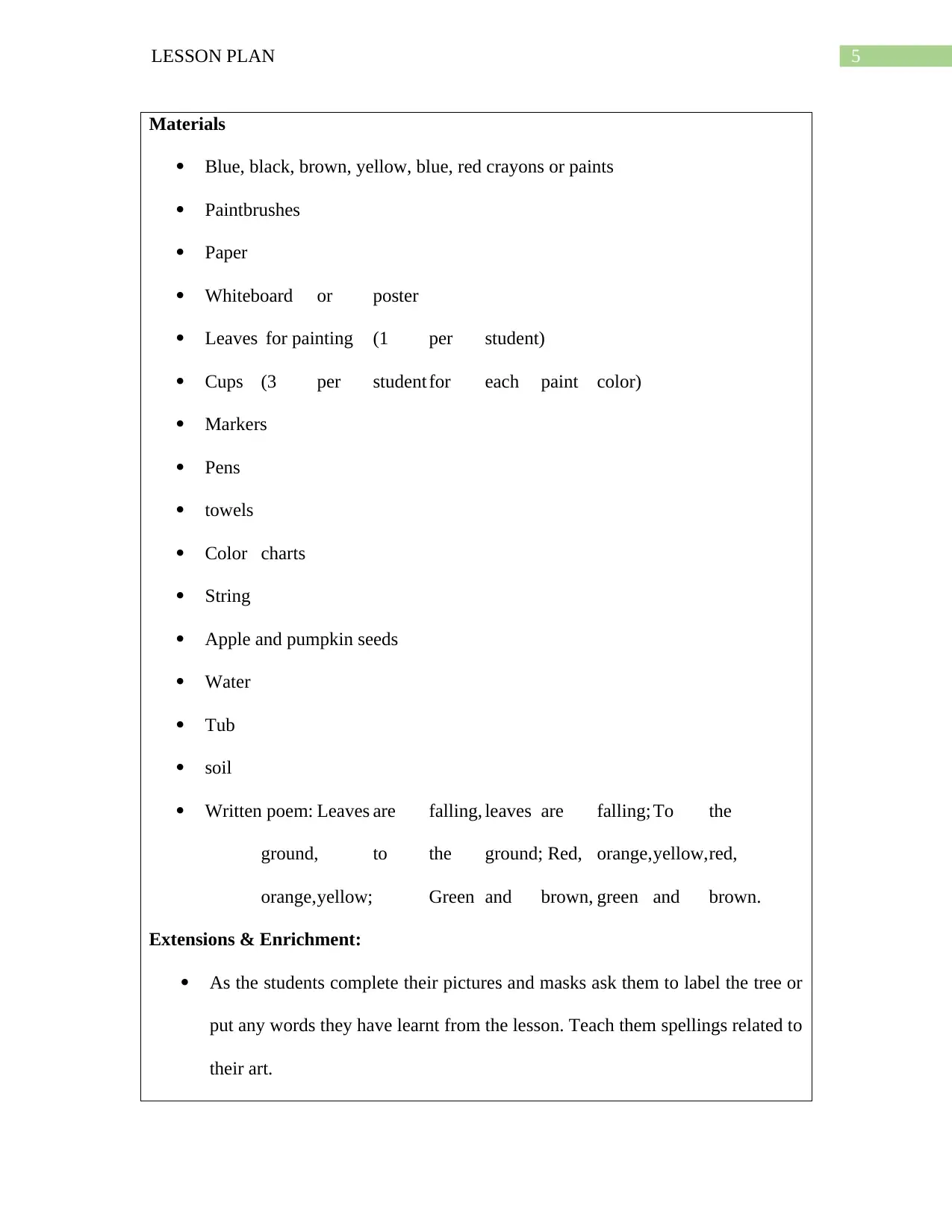
5LESSON PLAN
Materials
Blue, black, brown, yellow, blue, red crayons or paints
Paintbrushes
Paper
Whiteboard or poster
Leaves for painting (1 per student)
Cups (3 per student for each paint color)
Markers
Pens
towels
Color charts
String
Apple and pumpkin seeds
Water
Tub
soil
Written poem: Leaves are falling, leaves are falling; To the
ground, to the ground; Red, orange,yellow,red,
orange,yellow; Green and brown, green and brown.
Extensions & Enrichment:
As the students complete their pictures and masks ask them to label the tree or
put any words they have learnt from the lesson. Teach them spellings related to
their art.
Materials
Blue, black, brown, yellow, blue, red crayons or paints
Paintbrushes
Paper
Whiteboard or poster
Leaves for painting (1 per student)
Cups (3 per student for each paint color)
Markers
Pens
towels
Color charts
String
Apple and pumpkin seeds
Water
Tub
soil
Written poem: Leaves are falling, leaves are falling; To the
ground, to the ground; Red, orange,yellow,red,
orange,yellow; Green and brown, green and brown.
Extensions & Enrichment:
As the students complete their pictures and masks ask them to label the tree or
put any words they have learnt from the lesson. Teach them spellings related to
their art.
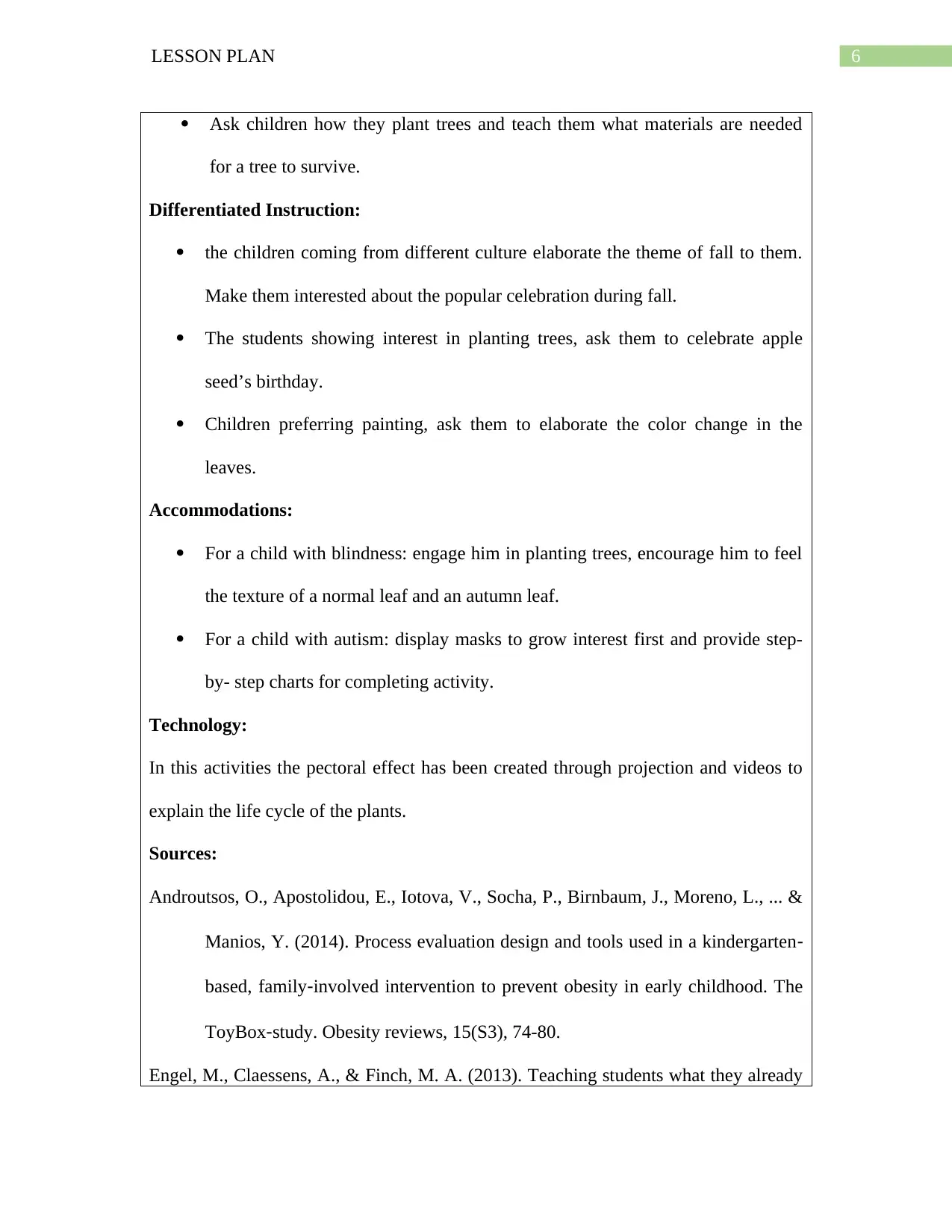
6LESSON PLAN
Ask children how they plant trees and teach them what materials are needed
for a tree to survive.
Differentiated Instruction:
the children coming from different culture elaborate the theme of fall to them.
Make them interested about the popular celebration during fall.
The students showing interest in planting trees, ask them to celebrate apple
seed’s birthday.
Children preferring painting, ask them to elaborate the color change in the
leaves.
Accommodations:
For a child with blindness: engage him in planting trees, encourage him to feel
the texture of a normal leaf and an autumn leaf.
For a child with autism: display masks to grow interest first and provide step-
by- step charts for completing activity.
Technology:
In this activities the pectoral effect has been created through projection and videos to
explain the life cycle of the plants.
Sources:
Androutsos, O., Apostolidou, E., Iotova, V., Socha, P., Birnbaum, J., Moreno, L., ... &
Manios, Y. (2014). Process evaluation design and tools used in a kindergarten‐
based, family‐involved intervention to prevent obesity in early childhood. The
ToyBox‐study. Obesity reviews, 15(S3), 74-80.
Engel, M., Claessens, A., & Finch, M. A. (2013). Teaching students what they already
Ask children how they plant trees and teach them what materials are needed
for a tree to survive.
Differentiated Instruction:
the children coming from different culture elaborate the theme of fall to them.
Make them interested about the popular celebration during fall.
The students showing interest in planting trees, ask them to celebrate apple
seed’s birthday.
Children preferring painting, ask them to elaborate the color change in the
leaves.
Accommodations:
For a child with blindness: engage him in planting trees, encourage him to feel
the texture of a normal leaf and an autumn leaf.
For a child with autism: display masks to grow interest first and provide step-
by- step charts for completing activity.
Technology:
In this activities the pectoral effect has been created through projection and videos to
explain the life cycle of the plants.
Sources:
Androutsos, O., Apostolidou, E., Iotova, V., Socha, P., Birnbaum, J., Moreno, L., ... &
Manios, Y. (2014). Process evaluation design and tools used in a kindergarten‐
based, family‐involved intervention to prevent obesity in early childhood. The
ToyBox‐study. Obesity reviews, 15(S3), 74-80.
Engel, M., Claessens, A., & Finch, M. A. (2013). Teaching students what they already
Paraphrase This Document
Need a fresh take? Get an instant paraphrase of this document with our AI Paraphraser
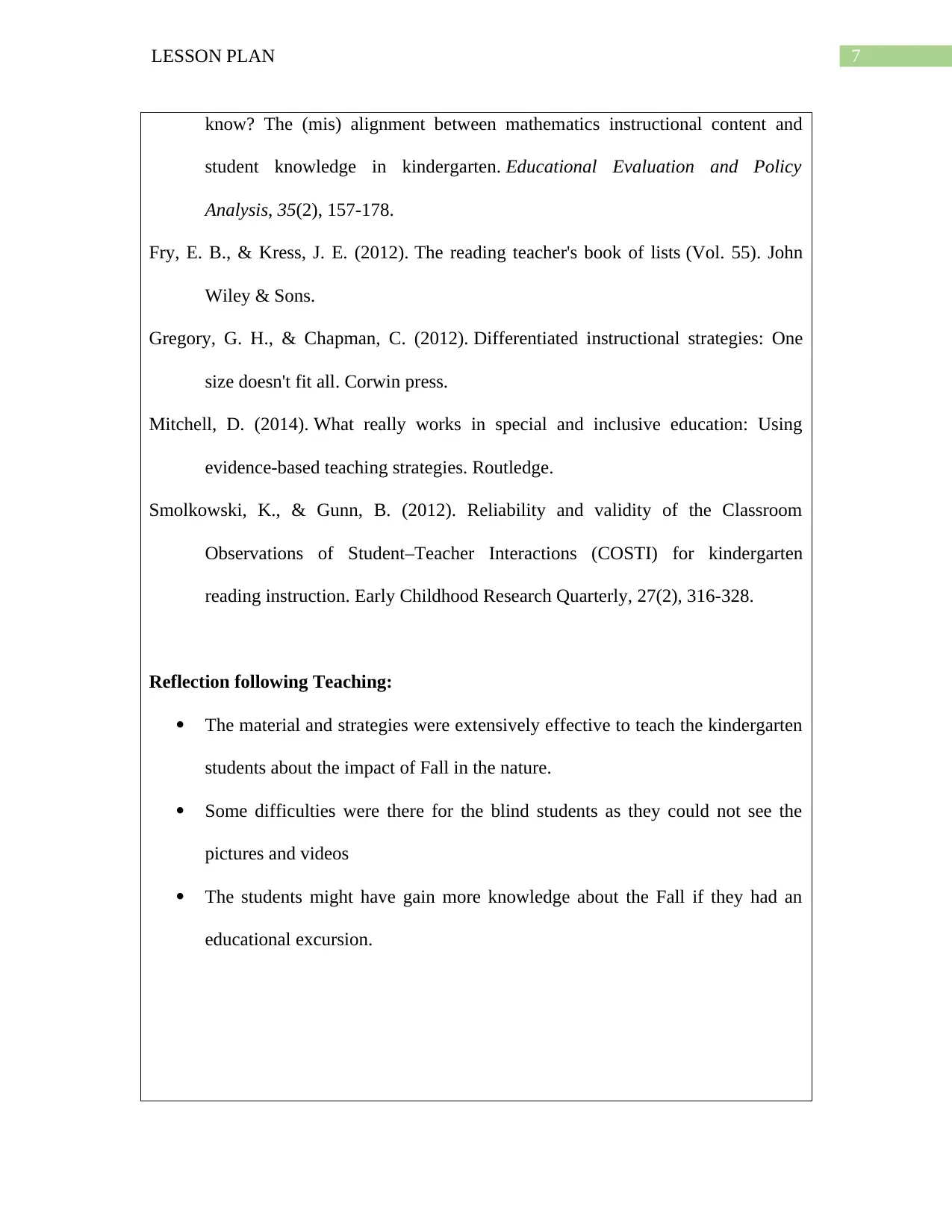
7LESSON PLAN
know? The (mis) alignment between mathematics instructional content and
student knowledge in kindergarten. Educational Evaluation and Policy
Analysis, 35(2), 157-178.
Fry, E. B., & Kress, J. E. (2012). The reading teacher's book of lists (Vol. 55). John
Wiley & Sons.
Gregory, G. H., & Chapman, C. (2012). Differentiated instructional strategies: One
size doesn't fit all. Corwin press.
Mitchell, D. (2014). What really works in special and inclusive education: Using
evidence-based teaching strategies. Routledge.
Smolkowski, K., & Gunn, B. (2012). Reliability and validity of the Classroom
Observations of Student–Teacher Interactions (COSTI) for kindergarten
reading instruction. Early Childhood Research Quarterly, 27(2), 316-328.
Reflection following Teaching:
The material and strategies were extensively effective to teach the kindergarten
students about the impact of Fall in the nature.
Some difficulties were there for the blind students as they could not see the
pictures and videos
The students might have gain more knowledge about the Fall if they had an
educational excursion.
know? The (mis) alignment between mathematics instructional content and
student knowledge in kindergarten. Educational Evaluation and Policy
Analysis, 35(2), 157-178.
Fry, E. B., & Kress, J. E. (2012). The reading teacher's book of lists (Vol. 55). John
Wiley & Sons.
Gregory, G. H., & Chapman, C. (2012). Differentiated instructional strategies: One
size doesn't fit all. Corwin press.
Mitchell, D. (2014). What really works in special and inclusive education: Using
evidence-based teaching strategies. Routledge.
Smolkowski, K., & Gunn, B. (2012). Reliability and validity of the Classroom
Observations of Student–Teacher Interactions (COSTI) for kindergarten
reading instruction. Early Childhood Research Quarterly, 27(2), 316-328.
Reflection following Teaching:
The material and strategies were extensively effective to teach the kindergarten
students about the impact of Fall in the nature.
Some difficulties were there for the blind students as they could not see the
pictures and videos
The students might have gain more knowledge about the Fall if they had an
educational excursion.

8LESSON PLAN
1 out of 9
Your All-in-One AI-Powered Toolkit for Academic Success.
+13062052269
info@desklib.com
Available 24*7 on WhatsApp / Email
![[object Object]](/_next/static/media/star-bottom.7253800d.svg)
Unlock your academic potential
© 2024 | Zucol Services PVT LTD | All rights reserved.